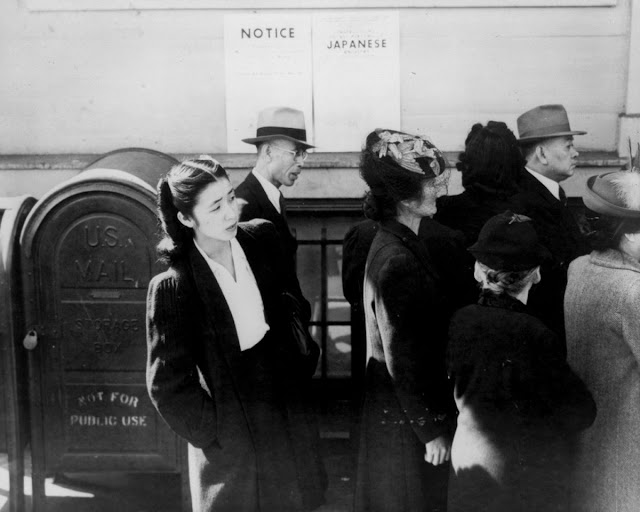President Franklin D. Roosevelt declared that the day of the Japanese attack on Pearl Harbor, December 7, 1941, would live in infamy. The attack launched the United States fully into the two theaters of the world war. Prior to Pearl Harbor, the United States had been involved in the European war only by supplying England and other antifascist countries of Europe with the munitions of war.
The attack on Pearl Harbor also launched a rash of fear about national security, especially on the West Coast. In February 1942, just two months after Pearl Harbor, President Roosevelt as commander-in-chief, issued Executive Order 9066, which had the effect of relocating all persons of Japanese ancestry, both citizens and aliens, inland, outside of the Pacific military zone. The objectives of the order were to prevent espionage and to protect persons of Japanese descent from harm at the hands of Americans who had strong anti-Japanese attitudes.
Roosevelt's order affected 117,000 people of Japanese descent, two-thirds of whom were native-born citizens of the United States. The Issei were the first generation of Japanese in this country; the Nisei were the second generation, numbering 70,000 American citizens at the time of internment. Within weeks, all persons of Japanese ancestry--whether citizens or enemy aliens, young or old, rich or poor--were ordered to assembly centers near their homes. Soon they were sent to permanent relocation centers outside the restricted military zones.
One of the most stunning ironies in this episode of American civil liberties was articulated by an internee who, when told that the Japanese were put in those camps for their own protection, countered "If we were put there for our protection, why were the guns at the guard towers pointed inward, instead of outward?"
 |
| Japanese-Americans ride on a train to an assembly center. (BETTMANN/GETTY IMAGES) |
 |
| First graders at a public school in San Francisco pledge allegiance to the flag before evacuations are ordered. (UNIVERSAL HISTORY ARCHIVE/UIG VIA GETTY IMAGES) |
 |
| A man in Pasadena packs his car with belongings before heading to the Manzanar War Relocation Camp. (BETTMANN/GETTY IMAGES) |
 |
| Soldiers escort an elderly Japanese-American couple from their home on Bainbridge Island, Washington. (LIBRARY OF CONGRESS/CORBIS/VCG VIA GETTY IMAGES) |
 |
| Japanese-Americans assemble in San Francisco for transportation to an assembly center, and later to various relocation centers. Photographer Dorothea Lange is visible above the crowd. (BETTMANN/GETTY IMAGES) |
 |
| The Mochida family of Hayward, California, await relocation. (GETTY IMAGES) |
 |
| Japanese-Americans in San Francisco line up to register for evacuation and housing. (LIBRARY OF CONGRESS) |
 |
| A boy sits on his belongings as he awaits relocation from San Francisco. (LIBRARY OF CONGRESS) |
 |
| Evacuees' baggage is piled up for transport at an assembly center in Salinas, California. (LIBRARY OF CONGRESS) |
 |
| Evacuees assemble at a Los Angeles railroad station. (LIBRARY OF CONGRESS) |
 |
| Evacuees in Los Angeles watch as trains carry their friends and relatives to Owens Valley. (LIBRARY OF CONGRESS) |
 |
| Evacuees wave goodbye to friends and relatives bound for Owens Valley. (LIBRARY OF CONGRESS) |
 |
| A child looks at a soldier as he assembles for evacuation with his family. (LIBRARY OF CONGRESS) |
 |
| (LIBRARY OF CONGRESS) |
 |
| (LIBRARY OF CONGRESS) |
 |
| Japanese-American-owned fishing boats sit idle in Los Angeles harbor. (LIBRARY OF CONGRESS) |
 |
| The last Japanese-American residents of Redondo Beach depart for relocation by truck. (LIBRARY OF CONGRESS) |
 |
| A Japanese-American-owned business in Oakland, California. (LIBRARY OF CONGRESS) |
 |
| A military police officer posts Civilian Exclusion Order No. 1, requiring evacuation of Japanese living on Bainbridge Island, Washington. (U.S. ARMY SIGNAL CORPS PHOTO./LIBRARY OF CONGRESS/CORBIS/VCG VIA GETTY IMAGES) |
 |
| Tom C. Clark, coordinator of the Alien Enemy Control program of the Western Defense Command. (BETTMANN/GETTY IMAGES) |
 |
| A technician bids farewell to his wife as he departs for Manzanar. (BETTMANN/GETTY IMAGES) |
 |
| John W. Abbott, left, an investigator for the Tolan Congressional Defense Committee on Migration, speaks to a young celery farmer who has just completed arrangements for leasing his farm during evacuation. (DOROTHEA LANGE/WRA/INTERIM ARCHIVES/GETTY IMAGES) |
 |
| Japanese-Americans escorted by soldiers cross a bridge as they are evacuated from Bainbridge Island to be taken to a relocation camp. (LIBRARY OF CONGRESS/CORBIS/VCG VIA GETTY IMAGES) |
 |
| A family awaits a ferry to Seattle and on to a relocation camp. (BETTMANN/GETTY IMAGES) |
 |
| San Francisco boys, one of them wearing a "Remember Pearl Harbor" hat, wave goodbye as they await relocation buses. (LIBRARY OF CONGRESS) |
 |
| (LIBRARY OF CONGRESS) |
 |
| (LIBRARY OF CONGRESS) |
 |
| A mother and daughter assemble for relocation at a Los Angeles train station. (LIBRARY OF CONGRESS) |
 |
| (LIBRARY OF CONGRESS) |
 |
| A Japanese-American-owned business in Los Angeles. (LIBRARY OF CONGRESS) |
(via
Mashable/Retronaut)





































